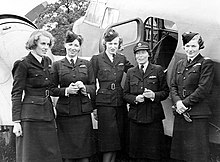Lettice Curtis


Lettice Curtis (born February 1, 1915 in Teignbridge , England, † July 21, 2014 in England ) was a British aviator and flight test engineer. She flew a wide range of combat aircraft on the Air Transport Auxiliary (ATA) and was the first woman to qualify to fly a 4-engine bomber. She got her helicopter license at the age of 77 .
life and work
Curtis was one of seven children of Eleanor Francis Meister and Walter Septimus Curtis , lord of the Denbury manors and lawyer of Lincoln's Inn , and granddaughter of the leading manufacturer of cotton spinning machines in Great Britain and three-time mayor of Manchester Matthew Curtis (mayor) . She attended Benenden School and studied mathematics at St Hilda's College , Oxford , where she was also the captain of the university’s women's lawn tennis and fencing team and played lacrosse for the university. In 1937 she received her first flying lessons at the Yapton Flying Club in Ford near Chichester and acquired a B-class license. She got a pilot job at Charles Lloyd Flugdienste, who took aerial photographs for mapping for the Southampton- based map maker Ordnance Survey . When the Second World War broke out , she was unemployed because the planes were not flown. However, the Ordnance Survey took her to the research department and she helped draw maps from aerial photographs. In 1940 she received a call from Pauline Gower , because there was an urgent need for more pilots. Since most of the men joined the Royal Air Force , it was decided to form a pool of women to increase the number of pilots. In 1940 she joined the ATA as one of the first female pilots and stayed until 1945 when the organization was closed. By the spring of 1941 there was a government decision that women were not allowed to fly operational aircraft and in September 1941 the ATA's women's division was opened in Hamble . There she was stationed under Margot Gore as Commander and Rosemary Rees as Deputy. She became one of the Spitfire Girls and flew Spits out of Southampton. After the war she bought a two-seater Wicko GM.1 ( license plate G-AFJB) from her former ATA friend Philippa Bennett. She used the Wicko to take part in the Thruxton Air Race in 1950 and also in the "Battle of Britain Anniversary Race" in Herne Bay . She competed with 3 women against 72 men. In 1951, Princess Elizabeth and Princess Margaret were at the Hatfield Aerodrome to watch them race against British male pilots. In 1952 she flew the Wicko again in the South Coast Air Race. After the war she became a technician and flight test observer with the Airplane and Armament Experimental Establishment for military aircraft in MoD Boscombe Down and later moved to Fairey Aviation Company , where she served as a senior flight development engineer. With the nationalization of the aircraft industry in the 1960s, she left Fairey Aviation to join the Department of Aviation. For several years she worked on the initial planning of the joint civil and RAF air traffic control center in West Drayton . She later worked for the UK Civil Aviation Administration for the Air Operations Directorate. In 1976 she took a job at a company that supplied the Sperry Corporation in Bracknell . She took an active part in British air races and flew various aircraft, including her Wicko and a Spitfire XI owned by the American air attaché in London. As a strong supporter of Concorde (her Concorde club number was 151), she made two flights on the famous airliner. She was a founding member of the British Women Pilots Association. In 1992 she qualified to fly helicopters and continued to fly airplanes until 1995.
Publications
- 1985: The Forgotten Pilots: A Story of the Air Transport Auxiliary , 1939-45, ISBN 978-0-947750-02-2 .
- 2004: Lettice Curtis: Her Autobiography , ISBN 978-0-9546201-1-0 .
literature
- Jackie Moggridge: Spitfire Girl , ISBN 978-1-4448-2531-2
- Lois K. Merry: Women Military Pilots of World War II , 2010, ISBN 978-0-7864-4441-0
Web links
| personal data | |
|---|---|
| SURNAME | Curtis, Lettice |
| BRIEF DESCRIPTION | British aviator and flight test engineer |
| DATE OF BIRTH | February 1, 1915 |
| PLACE OF BIRTH | Teignbridge , England |
| DATE OF DEATH | July 21, 2014 |
| Place of death | England |

